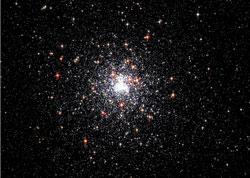Millisecond pulsar in spin mode

The NGC 6624 globular cluster in the Sagittarius constellation. The astronomers have identified a total of six pulsars in this globular cluster to date; the first one was J1823-3021A. Credit: Copyright NASA/ESA/I. King (University of California, Berkeley)<br>
Moreover, its high luminosity indicates that J1823-3021A is the youngest millisecond pulsar found to date, and that its magnetic field is much stronger than theoretically predicted. This therefore suggests the existence of a new population of such extreme objects. The discovery was made by Paulo Freire and an international team of scientists from the Max Planck Institute for Radio Astronomy in Bonn. The researchers evaluated data from the Fermi space telescope.
When the nuclear fuel in the core of a massive star is spent, the star collapses and releases so much energy in the process that it briefly radiates a billion times brighter than before. Such a supernova also marks the birth of a neutron star, an extremely compact atomic nucleus with a diameter of around 20 kilometres but several million times the mass of the Earth. The neutron star spins very rapidly about its axis and accelerated; charged particles emit electromagnetic radiation along the magnetic field lines in different wavelength bands. This radiation is bundled along the magnetic field's axis – like the light beam from a beacon.
Such a pulsar has rotational periods of between 16 milliseconds and eight seconds. The so-called millisecond pulsars, which have rotational periods down to 1.4 milliseconds, rotate even faster – this corresponds to 43,000 rotations per minute! It would seem that the initially lower rotational speed was subsequently increased as matter was accreted from a companion star. It is indeed the case that most of these millisecond pulsars can be found in binary star systems.
Millisecond pulsars have an extremely high rotational stability – even on long time scales; their cycle accuracy is comparable with that of the best atomic clocks on Earth. They are like huge flywheels in space, and hardly anything can affect their rotation. These objects can assist scientists to test the General Theory of Relativity; they can also be used in the search for gravitational waves and to analyse the properties of the superdense matter in the pulsar.
“We have now discovered more than 100 of these objects with radio telescopes,” says Paulo Freire from the Max Planck Institute for Radio Astronomy. “The high sensitivity of the Fermi telescope has now enabled us to track down a millisecond pulsar by its gamma radiation as well for the first time.” The researchers found the pulsar with the designation J1823−3021A in the centre of a globular cluster.
Globular clusters are very old swarms of hundreds of thousands of stars whose gravitational forces bind them to each other. They are home to a large number of binary star systems that can lead to the formation of millisecond pulsars. One of these star clusters is NGC 6624 out towards the Sagittarius constellation. It is in the central region of our Milky Way, around 27,000 light years away. The researchers have been able to find a total of six pulsars in this globular cluster; J1823-3021A was the first.
With a rotational period of only 5.44 milliseconds (11,000 rotations per minute) it is also the most luminous pulsar detected to date in a globular cluster. J1823-3021A had already been discovered in the radio band back in 1994. Since then, regular time sequence measurements have been carried out with large radio telescopes, in particular with the Lovell telescope of the University of Manchester (Great Britain) and the Nançay telescope in France.
“We were very surprised to discover that the pulsar radiates very brightly in the gamma radiation band as well,” says Damien Parent from the US Center for Earth Observing and Space Research. “We did not expect these millisecond pulsars to be so bright. This implies an unexpectedly strong magnetic field for such a rapidly rotating pulsar.”
“This is a challenge for our current theories regarding the formation of such pulsars,” explains Michael Kramer, Director at the Max Planck Institute in Bonn and head of the Fundamental Physics in Radio Astronomy research group there. “We are currently investigating a whole series of possible explanations. Nature might even be forming millisecond pulsars in a way that we do not even have on the radar as yet.”
“No matter how these anomalous pulsars might form, one thing seems to be certain,” says Paulo Freire: “In globular clusters, at least, these are objects so young that they are probably forming as often as the large number of normal millisecond pulsars which we already know about.”
Media Contact
More Information:
http://www.mpifr-bonn.mpg.deAll latest news from the category: Physics and Astronomy
This area deals with the fundamental laws and building blocks of nature and how they interact, the properties and the behavior of matter, and research into space and time and their structures.
innovations-report provides in-depth reports and articles on subjects such as astrophysics, laser technologies, nuclear, quantum, particle and solid-state physics, nanotechnologies, planetary research and findings (Mars, Venus) and developments related to the Hubble Telescope.
Newest articles

Superradiant atoms could push the boundaries of how precisely time can be measured
Superradiant atoms can help us measure time more precisely than ever. In a new study, researchers from the University of Copenhagen present a new method for measuring the time interval,…

Ion thermoelectric conversion devices for near room temperature
The electrode sheet of the thermoelectric device consists of ionic hydrogel, which is sandwiched between the electrodes to form, and the Prussian blue on the electrode undergoes a redox reaction…

Zap Energy achieves 37-million-degree temperatures in a compact device
New publication reports record electron temperatures for a small-scale, sheared-flow-stabilized Z-pinch fusion device. In the nine decades since humans first produced fusion reactions, only a few fusion technologies have demonstrated…





















